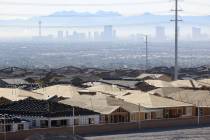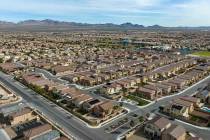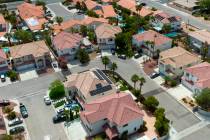Tumbling home prices seen
A national finance magazine predicts more big price drops in the Las Vegas housing market, and that devaluation could mean more pain for the local economy, experts say.
Money magazine, in its May 7 issue, placed Las Vegas near the top of its list of markets poised for declines in housing prices in the next 12 months.
The magazine ranked Las Vegas No. 5 in the country for projected value losses through May 2009, with an expected drop of 18.3 percent. That would send the local median home price of $277,000 down to a circa-2003 rate of around $225,000.
Locals shouldn't expect prices to bottom out until sometime between January and March 2010, the magazine added.
Markets in for worse times include Miami; Fort Lauderdale, Fla.; and Orlando, Fla., Money said. Phoenix tied with Las Vegas in anticipated depreciation. The nation as a whole should see price falloffs of 9.7 percent, the report said.
An 18.3 percent drop in home prices could further stall a local economy already posting slower consumer spending, with Clark County's taxable sales off 3.1 percent in February when compared with the same month a year earlier.
Every 1 percent in lost single-family home values prunes $800 million in wealth from Southern Nevada's households, according to Las Vegas research firm Applied Analysis. Include condominiums and townhomes, and locals' assets drop nearly $1 billion for every 1 percent slide in prices.
Devaluation shakes up consumers and discourages spending, and it also peels away the equity that finances home remodeling, trading up to a bigger place and even big-ticket purchases such as cars and vacations. Banks are already responding to the possibility of sustained depreciation: Countrywide Financial Corp. announced on May 6 that it had suspended home equity lines of credit for almost all of its Las Vegas customers.
"I don't want to understate the importance of mobility within the economy," said Jeremy Aguero, an Applied Analysis principal. "The reality is, a lot of people are either upside down on their homes or locked in, so people are waiting for the economy to be in a better position. Falling prices have a liquidity effect, as well as a real effect, on consumers."
But Aguero and other observers say Money's prognosis might be too negative.
They didn't completely dismiss the possibility of an 18.3 percent pricing drop. After all, few local economists expected prices to plummet more than 20 percent in one year, as they did from the first quarter of 2007 to the first quarter of 2008, according to the National Association of Realtors.
Because prices depreciated so much in 2007, though, the slide in prices should slow in the next year, they said.
"The last time we saw prices in that ($225,000) realm was in mid- to late 2003, so Money's numbers assume we're going to basically wipe out the last five years of appreciation," said Ken Perlman, vice president of Sullivan Group Real Estate Advisors. "It assumes no upward momentum in the marketplace at all over a five-year period. To me, intuitively, that sounds a little aggressive."
Prices will probably continue to soften in the coming year, Perlman said, but several factors point away from the significant dip Money's researchers augur.
First, the market is showing improved sales activity, according to data from the Greater Las Vegas Association of Realtors. Sales of homes sold through the trade group's members rose in April for the fourth month in a row, evidence that consumer appetite for buying property has improved, Perlman said. Inventories have stabilized as well, sitting between 22,000 and 23,000 homes listed for the last few months. And the weak U.S. dollar is piquing interest among foreign investors who now enjoy improved buying power stateside, Perlman added.
Perlman also noted that any discussion of depreciation needs to distinguish between lower prices and lower values. As builders erect more condominiums, townhomes and small, single-family homes to meet consumer demand for lower-maintenance lifestyles and more-affordable prices, median prices will fall, Perlman said. But that doesn't mean overall values -- what homes are worth -- have declined. To get at true value trends, consider prices per square foot, which are holding at $100 to $125 per square foot.
Money's editors, who used statistics from e-commerce provider Fiserv and mortgage-technology developer CoreLogic, didn't return calls seeking comment on their study's methodology by press time. Nonetheless, one local analyst took issue with the publication's unified look at the valley's housing future.
The new-home and resale markets are distinct animals, and they could each face different fortunes in the next 18 months, said Dennis Smith, president of local analysis firm Home Builders Research.
Home builders have pared new-home inventory to about 800 units marketwide -- around a two-month supply at current absorption rates. With so little supply, new-home prices shouldn't shed 18.3 percent of their value, Smith said. Builders would simply halt construction before they would sell homes for so much less, he added.
Cloudier prospects beset the existing-home sector, on the other hand, mostly because of the large number of bank-owned properties and homes in foreclosure. About 7,000 local listings -- nearly one-third of the market -- are foreclosure properties.
"Lenders have all these properties, and we're not sure how long they'll hold those properties, or whether they might try to dump them all on the market at the same time," Smith said. "Most bankers say they won't do that, that they're not in business to lose money. But (bank-owned) properties are key to this market. We're in the hands of the lenders."
It's conceivable that existing single-family homes, which posted a median price of around $236,000 in April, according to the Realtors association, could drop to that Money estimate of around $225,000 in the next year, Smith said, but that wouldn't constitute the 18.3 percent drop the magazine's editors expect.
Analysts were mixed on whether the market would bottom out in early 2010.
Smith said he didn't expect substantial upticks in activity among new-home sales in 2009, so that market segment could stay sluggish through early 2010. And Perlman said planning to be "in the midst of a full rebound in 2009 might be a little premature."
But Aguero said Money's prediction of a 2010 turnaround is a year or so behind what his research indicates.
"By early 2010, we'll already have had the opening of CityCenter, requiring 12,500 new employees, and we'll be within 12 months of the opening of Echelon, with another 12,000 employees. Our expectation is to see a bottoming-out by the end of 2008."
Contact reporter Jennifer Robison at jrobison@reviewjournal.com or 702-380-4512.























